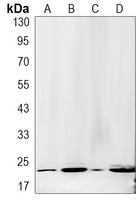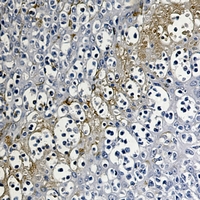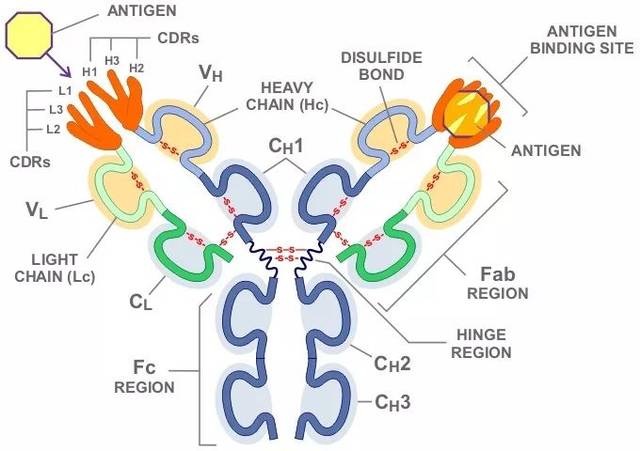Product Name :
RKIP Rabbit monoclonal antibody Background :
Raf kinase inhibitor protein (RKIP) is a member of the phosphatidylethanolamine-binding protein (PEBP) family that associates with Raf-1 and the MEK and MAP kinases . RKIP has been shown to form a complex with Raf-1, MEK, and Erk (2). Although MEK and Erk can simultaneously bind RKIP, the association between Raf-1 and RKIP and that of RKIP and MEK are mutually exclusive. Thus, RKIP competitively disrupts the Raf-1-MEK complex and effectively terminates signal transmission from Raf-1 to MAP kinases . The inhibitory effect of RKIP on MAP kinase signaling is eliminated by PKC phosphorylation of RKIP at Ser153. PKC phosphorylation on Ser153 also promotes the association of RKIP with GRK2, which prevents GRK2-dependent internalization of GPCR . RKIP also interacts with modules of the NF-κB pathway, including NF-κB-inducing kinase (NIK), TAK1, IKKα and IKKβ . These interactions antagonize cytokine-induced activation of the NF-κB pathway . Restoration of RKIP expression is associated with the inhibition of prostate cancer metastasis, implying that RKIP may be a potential clinical target as a suppressor of tumor metastasis through inhibition of vascular invasion . Product :
Liquid in 50mM Tris-Glycine (pH 7.4), 0.15M NaCl, 50% Glycerol, 0.01% Sodium azide and 0.05% BSA. Storage&Stability :
Store at 4°C short term. Aliquot and store at -20°C long term. Avoid freeze-thaw cycles. Specificity :
Recognizes endogenous levels of RKIP protein. Immunogen :
A synthetic peptide of human RKIP Conjugate :
Unconjugated Modification :
Unmodification
RKIP Rabbit monoclonal antibody Background :
Raf kinase inhibitor protein (RKIP) is a member of the phosphatidylethanolamine-binding protein (PEBP) family that associates with Raf-1 and the MEK and MAP kinases . RKIP has been shown to form a complex with Raf-1, MEK, and Erk (2). Although MEK and Erk can simultaneously bind RKIP, the association between Raf-1 and RKIP and that of RKIP and MEK are mutually exclusive. Thus, RKIP competitively disrupts the Raf-1-MEK complex and effectively terminates signal transmission from Raf-1 to MAP kinases . The inhibitory effect of RKIP on MAP kinase signaling is eliminated by PKC phosphorylation of RKIP at Ser153. PKC phosphorylation on Ser153 also promotes the association of RKIP with GRK2, which prevents GRK2-dependent internalization of GPCR . RKIP also interacts with modules of the NF-κB pathway, including NF-κB-inducing kinase (NIK), TAK1, IKKα and IKKβ . These interactions antagonize cytokine-induced activation of the NF-κB pathway . Restoration of RKIP expression is associated with the inhibition of prostate cancer metastasis, implying that RKIP may be a potential clinical target as a suppressor of tumor metastasis through inhibition of vascular invasion . Product :
Liquid in 50mM Tris-Glycine (pH 7.4), 0.15M NaCl, 50% Glycerol, 0.01% Sodium azide and 0.05% BSA. Storage&Stability :
Store at 4°C short term. Aliquot and store at -20°C long term. Avoid freeze-thaw cycles. Specificity :
Recognizes endogenous levels of RKIP protein. Immunogen :
A synthetic peptide of human RKIP Conjugate :
Unconjugated Modification :
Unmodification
-
 Western blot analysis of RKIP expression in rat brain (A), C6 (B), NIH3T3 (C), Hela (D) whole cell lysates.
Western blot analysis of RKIP expression in rat brain (A), C6 (B), NIH3T3 (C), Hela (D) whole cell lysates. -
 Immunohistochemical analysis of RKIP staining in human tonsil formalin fixed paraffin embedded tissue section. The section was pre-treated using heat mediated antigen retrieval with sodium citrate buffer (pH 6.124). The section was then incubated with the antibody at room temperature and detected using an HRP conjugated compact polymer system. DAB was used as the chromogen. The section was then counterstained with haematoxylin and mounted with DPX.
Immunohistochemical analysis of RKIP staining in human tonsil formalin fixed paraffin embedded tissue section. The section was pre-treated using heat mediated antigen retrieval with sodium citrate buffer (pH 6.124). The section was then incubated with the antibody at room temperature and detected using an HRP conjugated compact polymer system. DAB was used as the chromogen. The section was then counterstained with haematoxylin and mounted with DPX.
Bioworld Biotech only provide peptides for our antibodies and do not provide additional peptide customization services.
Price/Size :
USD 368/1mg/vial
Tips:
For phospho antibody, we provide phospho peptide(0.5mg) and non-phospho peptide(0.5mg).Describe :
Blocking peptides are peptides that bind specifically to the target antibody and block antibody binding. These peptide usually contains the epitope recognized by the antibody. Antibodies bound to the blocking peptide no longer bind to the epitope on the target protein. This mechanism is useful when non-specific binding is an issue, for example, in Western blotting (WB) and Immunohistochemistry (IHC). By comparing the staining from the blocked antibody versus the antibody alone, one can see which staining is specific; Specific binding will be absent from the western blot or IHC performed with the neutralized antibody.Formula:
Synthetic peptide was lyophilized with 100% acetonitrile and is supplied as a powder. Reconstitute with 0.1 ml DI water for a final concentration of 10 mg/ml.The purity is >90%,tested by HPLC and MS.
Storage:
The freeze-dried powder is more stable. For short time at 2-8°C. For long term storage store at -20°C.
Note :
This product is for research use only (RUO only). Not for use in diagnostic or therapeutic procedures.
 RKIP Rabbit monoclonal antibody
RKIP Rabbit monoclonal antibody  Datasheet
Datasheet COA
COA MSDS
MSDS SHIP
SHIP